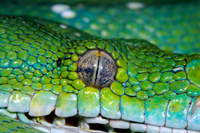Some believe snakes are capable of pretty weird behaviors.
Today is Groundhog Day, and this has gotten me to thinking about myths that are associated with animals. Whether or not you consider a groundhog’s actions an accurate forecast of spring or a myth known primarily as the setting for a very good Bill Murray movie, people do sometimes attribute animals with weird powers and abilities. This hairy little weather forecaster aside, reptiles, too, have been the subject of some pretty odd thinking along these lines.

The unblinking eye of a snake creates a hypnotic effect.
It comes as no surprise, of course, that the snake is the reptile most commonly bestowed with mythic abilities. One that is fairly well known is the myth that snakes have hypnotic abilities. A snake’s capacity to hypnotize its prey has been portrayed in books and movies for many years, perhaps most memorably through Kaa, a python in Disney’s animated version of The Jungle Book (1967) that uses hypnosis to subdue his victims. Check out the You Tube clip at the bottom of this blog to see Kaa’s hypno-eyes in action.
There are two factors that likely contribute to the belief that snakes can hypnotize their prey, and neither has anything to do with a watch being swung back and forth. First is a snake’s lack of eyelids. The resulting unblinking stare gives snakes a bit of a hypnotic aura right off the bat. Second is the tendency of living prey animals to freeze up, possibly in fear, when in close proximity to a snake. Some may run, but not all. Animals that sense danger will often remain motionless, in the hope (assuming animals can hope) that the predator that is approaching or confronting them will not see them if they are not moving. To them, stillness equals invisibility. Combine these two factors — an unblinking snake staring at an animal that is not moving – and the tableaux seems to illustrate hypnotism at work.
Snakes don’t just hypnotize others; some believe they are prone to being hypnotized themselves, most famously by a snake charmer’s flute. During such exhibitions, a snake under the influence of the charmer’s melodious tones — most often a cobra, which may have had its venom glands or fangs removed — will sway back and forth. This gives the impression that the snake is hearing the music and is held in its sway. The truth, though, is the snake is simply following the back-and-forth motion of the snake charmer’s arms that are holding the flute. It’s wary should a grab be made at it.
Then there’s the “hoop snake.” This is a snake that can glom onto its tail with its teeth, forming an upright circle, which it will do in order to roll after a quarry. Once it catches up, a stinger on the tail will proceed stinging. The origins of this myth appear to go way back, back much further than I really care to research at the moment. Suffice it to say, there are people who still think snakes can form hoops and roll after them. Speaking of pursuit, another myth is that snakes will chase people. If you know snakes like I know snakes, then you know that all a wild snake wants to do is get away from people, not chase them. Of course, a snake that’s cornered will defend itself, but snakes are not in the habit of chasing after humans. They themselves get chased plenty, though, including, as you can see if you watch the You Tube video posted below, by rabbits.
A very common myth about snakes is that they’re slimy. Wrongo! Snakes aren’t slimy at all. They’re smooth and glossy due to their scale structure, and their somewhat shiny appearance leads some people to think that they’re slimy. I suppose the fact that they slither may contribute to this myth because some creatures that slither along the ground, such as snails, slugs and worms, can be somewhat slimy.
The names of some snakes lead to myths. Corn snakes don’t eat corn and milk snakes don’t drink milk, yet their names have perpetuated such beliefs. Corn snakes are so named because of the likelihood that they can be found in the vicinity of corn silos, fields, etc. because these places are also home to their rodent prey. Milk snakes, too, may be found on farms because this is where rodents dwell. They do not, as the myth goes, latch onto cow udders and suck milk from them.
One myth I find particularly amusing is the deadly breath of the hognose snake. Also known in some circles as puff adders (no relation to the deadly Bitis arietans), some believe that these snakes can mix poison with their breath, and exhale a toxic vapor that could kill from 25 feet away! Of course, this fallacy has been fueled by a hognose’s ability to puff up and flatten its body while hissing loudly. Perhaps I’ll make double sure this is a myth at the next reptile expo I attend at which hognose snakes are for sale.
I’ll likely delve into other myths about other types of reptiles in future blogs, but before I go, I have one more thing to say about Groundhog Day. Does Punxsutawney Phil really have to see his shadow on the big day? Or is the fact that he’s casting a shadow sufficient evidence that there are six weeks left of winter weather? After all, just because his head may be pointed at his shadow doesn’t mean he’s actually looking at it, does it? How can anyone determine with certainty that Phil is actually seeing his shadow? This is one of the great imponderables of the universe, and one that I will undoubtedly be contemplating heavily for at least the next five seconds.


